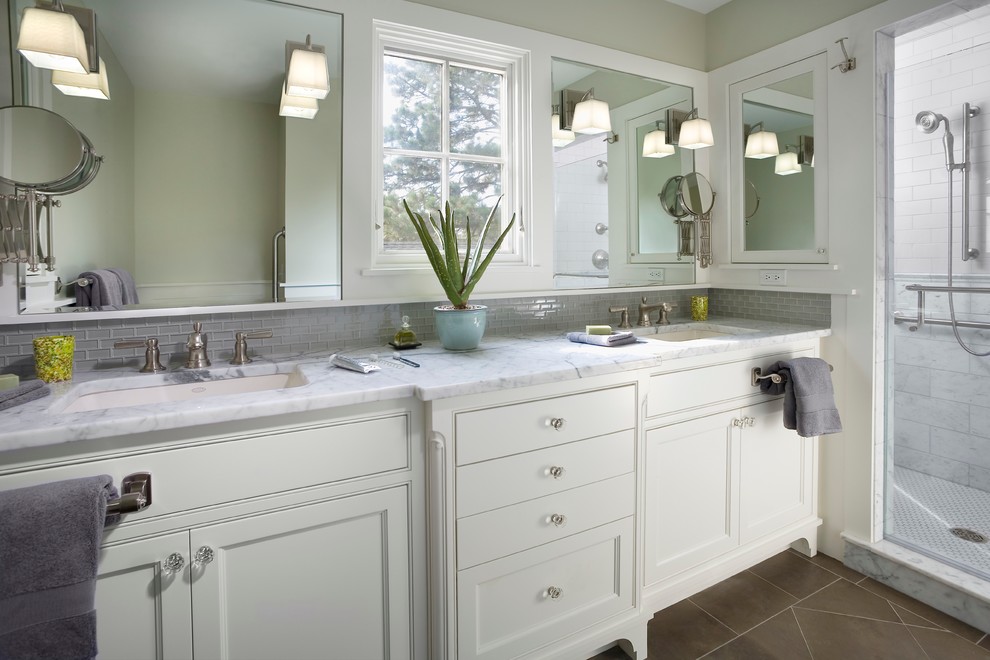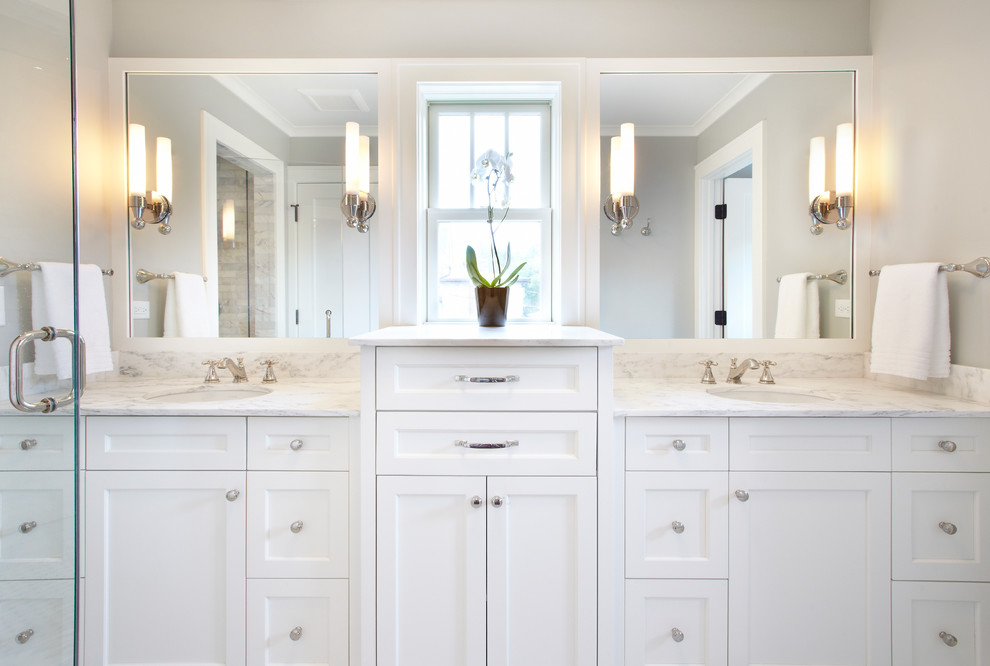Popular Bathroom Countertop Materials in St. Paul

St. Paul homeowners are increasingly seeking out stylish and durable bathroom countertop materials that reflect their personal taste and enhance the overall aesthetic of their space. The city’s diverse architectural landscape and homeowner preferences have led to a wide range of countertop options, each with its own unique advantages and considerations.
Comparison of Popular Countertop Materials
The selection of bathroom countertop materials is influenced by factors such as durability, maintenance requirements, aesthetic appeal, and budget. Here’s a detailed comparison of some of the most popular materials used in St. Paul bathrooms:
Granite
Granite is a natural stone known for its durability, scratch resistance, and heat resistance. It comes in a wide variety of colors and patterns, making it a versatile option for different bathroom styles.
Pros:
- High durability and scratch resistance
- Heat resistance
- Unique and natural patterns
- Available in a wide range of colors
Cons:
- Porous, requiring sealing to prevent staining
- Can be susceptible to etching from acidic substances
- High initial cost
Quartz
Quartz is an engineered stone that combines natural quartz crystals with resin and pigments. It offers a sleek and modern look, along with high durability and low maintenance requirements.
Pros:
- Non-porous and stain-resistant
- Scratch-resistant and durable
- Available in a wide range of colors and patterns
- Low maintenance
Cons:
Marble
Marble is a natural stone known for its elegance and timeless beauty. It adds a luxurious touch to any bathroom, but it requires careful maintenance.
Pros:
- Unique and elegant veining
- Soft and cool to the touch
Cons:
Laminate
Laminate is a cost-effective option that offers a wide range of colors and patterns to mimic the look of natural stone. It’s a popular choice for budget-conscious homeowners.
Pros:
Cons:
Concrete
Concrete countertops are gaining popularity for their unique and industrial look. They can be customized with various finishes and colors.
Pros:
- Durable and heat-resistant
- Can be customized with different colors and finishes
- Unique and modern look
Cons:
Price Range of Countertop Materials
The price of bathroom countertops varies depending on the material, quality, and installation costs. Here’s a general price range for each material:
| Material | Price Range per Square Foot |
|---|---|
| Granite | $50 – $150 |
| Quartz | $60 – $120 |
| Marble | $75 – $200 |
| Laminate | $20 – $50 |
| Concrete | $75 – $150 |
Bathroom Countertop Styles in St. Paul

St. Paul homeowners are increasingly embracing diverse bathroom countertop styles, reflecting their unique preferences and the evolving trends in home design. Whether you lean towards the sleek lines of contemporary design, the timeless elegance of traditional aesthetics, or the harmonious blend of transitional style, St. Paul offers a wealth of options to personalize your bathroom.
Contemporary Bathroom Countertop Styles
Contemporary bathroom countertop styles prioritize clean lines, minimalist aesthetics, and a focus on functionality. These styles often feature bold geometric shapes, sleek edges, and a limited use of ornamentation.
Popular Countertop Shapes in Contemporary Style
Contemporary bathrooms often feature countertops with rectangular or square shapes, emphasizing simplicity and a sense of spaciousness. These shapes are well-suited for smaller bathrooms, maximizing available space.
Edges and Finishes in Contemporary Countertop Styles
Contemporary bathrooms often feature countertops with straight edges, enhancing the minimalist aesthetic. Polished finishes, such as those found in granite or quartz, are common, reflecting light and adding a sense of sophistication.
Materials for Contemporary Bathroom Countertop Styles
Contemporary bathroom countertops often utilize materials that are both durable and stylish. Quartz is a popular choice, known for its non-porous surface, resistance to stains, and wide range of colors. Engineered stone, such as Caesarstone or Silestone, also provides a contemporary look with a variety of colors and patterns.
Traditional Bathroom Countertop Styles
Traditional bathroom countertop styles evoke a sense of timeless elegance, often featuring intricate details, classic shapes, and warm color palettes. These styles embrace a sense of history and craftsmanship, creating a welcoming and inviting atmosphere.
Popular Countertop Shapes in Traditional Style
Traditional bathroom countertops often feature curved or rounded shapes, creating a sense of softness and sophistication. These shapes can range from subtle curves to more pronounced arches, adding a touch of visual interest.
Edges and Finishes in Traditional Countertop Styles
Traditional bathroom countertops often feature beveled or eased edges, creating a sense of refinement and craftsmanship. The edges are often softened, creating a more inviting and comfortable feel. Matte finishes, such as those found in honed marble or soapstone, are common, adding a sense of warmth and elegance.
Materials for Traditional Bathroom Countertop Styles
Traditional bathroom countertops often utilize materials that are both durable and classic. Marble is a popular choice, known for its natural beauty, veining patterns, and timeless elegance. Granite is also a good choice, offering durability and a wide range of colors and patterns.
Transitional Bathroom Countertop Styles
Transitional bathroom countertop styles bridge the gap between contemporary and traditional design, blending modern elements with classic details. This style creates a balanced and harmonious look, combining the clean lines of contemporary design with the warmth and elegance of traditional aesthetics.
Popular Countertop Shapes in Transitional Style
Transitional bathroom countertops often feature a combination of straight and curved shapes, creating a balanced and visually appealing look. Rectangular or square shapes with rounded corners or subtle curves are common, providing a sense of both modern and traditional elements.
Edges and Finishes in Transitional Countertop Styles
Transitional bathroom countertops often feature a combination of straight and beveled edges, creating a balanced and refined look. Polished or honed finishes are common, depending on the desired level of sheen and the overall aesthetic.
Materials for Transitional Bathroom Countertop Styles
Transitional bathroom countertops often utilize materials that offer both durability and a sense of style. Quartz is a popular choice, offering a wide range of colors and patterns, as well as durability and low maintenance. Engineered stone can also be a good option, providing a variety of colors and textures, while offering a modern and sleek look.
Table of Bathroom Countertop Styles, St paul bathroom countertops
| Style | Image | Description |
|---|---|---|
| Contemporary | [Image of a contemporary bathroom countertop with a sleek, minimalist design, featuring straight edges and a polished finish. The countertop is made of quartz, showcasing a solid color with subtle veining.] | Clean lines, minimalist aesthetics, bold geometric shapes, sleek edges, limited ornamentation. |
| Traditional | [Image of a traditional bathroom countertop with a curved shape and beveled edges, featuring a honed finish. The countertop is made of marble, showcasing a natural pattern with subtle veining.] | Intricate details, classic shapes, warm color palettes, a sense of history and craftsmanship. |
| Transitional | [Image of a transitional bathroom countertop with a combination of straight and curved shapes, featuring a polished finish. The countertop is made of engineered stone, showcasing a blend of modern and traditional elements.] | Blends modern elements with classic details, clean lines with warmth and elegance. |
Considerations for Choosing Bathroom Countertops in St. Paul: St Paul Bathroom Countertops

Transforming your bathroom into a sanctuary of style and functionality requires careful consideration of every detail, including the countertop. Choosing the right bathroom countertop material is an investment that will impact the look, feel, and longevity of your space. Let’s explore the key factors to guide your decision.
Budget Considerations
The budget plays a crucial role in determining the range of countertop materials you can explore. It’s essential to establish a realistic budget and understand the typical price ranges for different materials.
- Budget-Friendly Options: Laminate, engineered stone, and tile offer affordable options without compromising on style. Laminate countertops are known for their durability and affordability, while engineered stone provides a more luxurious look at a reasonable price point. Tile offers endless design possibilities and can be customized to fit your aesthetic.
- Mid-Range Options: Solid surface countertops, such as Corian, offer a seamless, non-porous surface that is easy to maintain. They come in a variety of colors and patterns, providing flexibility in design.
- Luxury Options: Natural stone, including granite, marble, and quartz, elevates the bathroom’s elegance. These materials are known for their unique veining, durability, and timeless appeal. However, they come with a higher price tag and require specialized care.
Lifestyle and Usage
Your lifestyle and how you use your bathroom are crucial factors in selecting the right countertop material. Consider your daily routines, the number of people using the bathroom, and the level of wear and tear you anticipate.
- High-Traffic Bathrooms: For bathrooms with heavy usage, durability is paramount. Materials like granite, quartz, and engineered stone are highly resistant to scratches, stains, and heat, making them ideal for busy families.
- Minimalist Bathrooms: If you prefer a clean, modern aesthetic, consider materials like solid surface or laminate that offer a seamless look. These materials are also easy to clean and maintain.
Personal Preferences
Ultimately, the final decision comes down to your personal preferences. Explore the different countertop materials and styles to find what resonates with your vision.
- Color and Pattern: Consider the overall color scheme and style of your bathroom when choosing countertop colors and patterns. A contrasting countertop can add a pop of color, while a complementary countertop can create a cohesive look.
- Texture and Finish: The texture and finish of the countertop can impact the overall feel of the bathroom. Polished surfaces offer a sleek and modern look, while honed surfaces provide a more rustic and natural feel.
- Maintenance Requirements: Different materials require varying levels of maintenance. Some materials, like natural stone, require regular sealing to prevent staining, while others, like laminate, are more low-maintenance.
Functionality and Durability
In high-traffic areas like the bathroom, the functionality and durability of the chosen countertop material are paramount.
- Water Resistance: Bathrooms are prone to moisture, so choosing a water-resistant material is crucial. Natural stone, quartz, and engineered stone are inherently resistant to water damage.
- Stain Resistance: Countertops are susceptible to stains from cosmetics, toiletries, and spills. Choose materials that are stain-resistant or easily cleaned, such as granite, quartz, and engineered stone.
- Heat Resistance: The bathroom countertop may encounter heat from styling tools or hot water. Materials like granite, quartz, and engineered stone are heat-resistant and can withstand the occasional hot styling tool.
Questions to Ask Potential Contractors or Suppliers
To ensure an informed decision, it’s essential to ask potential contractors or suppliers a series of questions:
- What are the different countertop materials you offer?
- What are the pros and cons of each material?
- What are the typical price ranges for each material?
- What is the warranty on the countertop material?
- Do you offer any financing options?
- Can you provide references from previous clients?
St paul bathroom countertops – So, you’re thinking about upgrading your St. Paul bathroom, huh? Maybe a new countertop, some sleek fixtures, the whole shebang! But don’t forget the details, like a killer rug! A star wars bathroom rug can add a fun touch to any bathroom, whether you’re going for a minimalist vibe or a full-on galactic theme.
And with a little creativity, you can find a rug that complements your new St. Paul bathroom countertop perfectly.
St. Paul bathroom countertops are totally your jam, especially if you’re going for a sleek and sophisticated vibe. Think polished marble, gleaming quartz, or even a cool concrete look. If you’re feeling extra fancy, you could even go for a modern art deco bathroom with geometric patterns and bold accents.
Whatever your style, there’s a St. Paul countertop that’s perfect for your bathroom reno.